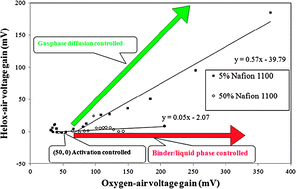Influence of binder properties on kinetic and transport processes in polymer electrolyte fuelcellelectrodes
Abstract
The objectives of this study are to estimate the contributions of kinetic, ohmic and mass

* Corresponding authors
a
Center for Electrochemical Science and Engineering, Department of Chemical & Biological Engineering, Illinois Institute of Technology, Chicago, Illinois 60616, USA
E-mail:
ramani@iit.edu
Fax: (312) 567-8874
Tel: (312) 567-3064
The objectives of this study are to estimate the contributions of kinetic, ohmic and mass

 Please wait while we load your content...
Something went wrong. Try again?
Please wait while we load your content...
Something went wrong. Try again?
S. Sambandam and V. Ramani, Phys. Chem. Chem. Phys., 2010, 12, 6140 DOI: 10.1039/B921916A
To request permission to reproduce material from this article, please go to the Copyright Clearance Center request page.
If you are an author contributing to an RSC publication, you do not need to request permission provided correct acknowledgement is given.
If you are the author of this article, you do not need to request permission to reproduce figures and diagrams provided correct acknowledgement is given. If you want to reproduce the whole article in a third-party publication (excluding your thesis/dissertation for which permission is not required) please go to the Copyright Clearance Center request page.
Read more about how to correctly acknowledge RSC content.
 Fetching data from CrossRef.
Fetching data from CrossRef.
This may take some time to load.
Loading related content
